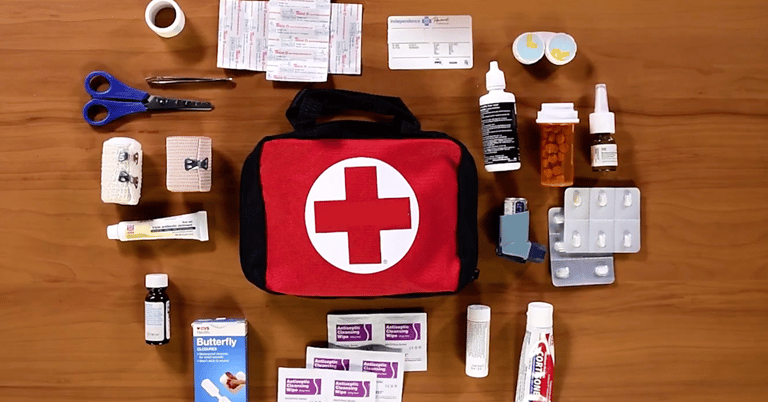Building a Comprehensive First Aid Kit: Everything You Need to Stay Prepared
Learn how to build a complete first aid kit with essential medical supplies. Be ready for emergencies with our expert guide to first aid preparedness and safety.
8/10/20253 min read
When it comes to emergency preparedness, a well-stocked first aid kit is one of the most important tools you can have. Whether you are prepping for natural disasters, outdoor adventures, or everyday accidents, having the right medical supplies on hand can make all the difference.
Building a comprehensive first aid kit is more than just buying a basic box of bandages. It requires thoughtful planning, understanding what supplies are essential, and tailoring your kit to your family’s needs.
In this guide, we will walk you through everything you need to create a first aid kit that is ready to handle common injuries, medical emergencies, and unexpected situations with confidence.
Why You Need a Comprehensive First Aid Kit
Accidents happen when you least expect them. Cuts, burns, sprains, allergic reactions, and other injuries can occur at home, on the road, or in the wilderness. Having a first aid kit means you are prepared to provide immediate care, reduce the risk of infection, and even save lives.
In emergencies where professional medical help might be delayed, a well-equipped first aid kit allows you to stabilize conditions and comfort injured persons. It also helps reduce panic and confusion when every second counts.
Core Components of a First Aid Kit
A truly comprehensive first aid kit covers basic wound care, injury treatment, and emergency response. Below are the essential categories and supplies to include:
Wound Care Supplies
Adhesive Bandages in various sizes for small cuts and scrapes
Sterile Gauze Pads to cover larger wounds and control bleeding
Medical Tape to secure dressings and bandages
Antiseptic Wipes or Solutions such as alcohol or iodine for cleaning wounds
Antibiotic Ointment to prevent infection
Elastic Bandages for sprains and strains
These items are the backbone of your kit and allow you to treat most minor injuries quickly and safely.
Tools and Instruments
Scissors with a blunt tip for cutting tape and clothing
Tweezers for removing splinters or debris from wounds
Disposable Gloves to protect yourself and others from infection
Thermometer to monitor fever or illness
CPR Face Shield or Mask to provide rescue breaths safely
Having the right tools ensures you can perform first aid procedures efficiently and hygienically.
Medications and Pain Relief
Pain Relievers such as ibuprofen, acetaminophen, or aspirin for aches and inflammation
Antihistamines to manage allergic reactions
Hydrocortisone Cream for insect bites, rashes, and skin irritation
Burn Cream or Aloe Vera Gel to soothe burns and sunburns
Oral Rehydration Salts to prevent dehydration during illness
These medicines provide relief and address common health issues in an emergency. Always check for allergies or contraindications before use.
Emergency and Specialty Items
Instant Cold Packs to reduce swelling and pain
Emergency Blanket to retain body heat in shock or cold conditions
First Aid Manual or Instruction Guide for quick reference
Splints or Finger Splints to immobilize fractures or sprains
Medical Alert Cards or Information for family members with chronic conditions
Including these supplies prepares you for less common but critical situations.
Tailoring Your First Aid Kit
No two households are exactly alike, so customize your kit based on your unique needs:
Include prescription medications and personal medical supplies like inhalers or EpiPens
Consider the ages and health conditions of family members, including infants and seniors
Add extra supplies if you live in remote areas or plan to travel or camp frequently
Make sure to replace expired items regularly and keep a checklist for maintenance
How to Store Your First Aid Kit
Store your kit in a durable, waterproof container that is easy to carry and open. Label it clearly and place it in an accessible location known to all family members.
Consider having multiple kits for home, car, workplace, and outdoor activities. This ensures you are covered no matter where you are.
Training and Preparedness
A first aid kit is only as useful as your knowledge of how to use it. Taking a basic first aid and CPR course can boost your confidence and ability to respond effectively during emergencies. Many organizations like the American Red Cross offer affordable training sessions.
Practice scenarios and keep your kit stocked and organized so you can act quickly and calmly when needed.
Common Mistakes to Avoid
Overpacking: Avoid adding unnecessary items that clutter your kit and make it hard to find what you need
Ignoring Expiration Dates: Regularly check and replace expired medicines and supplies
Lack of Accessibility: Don’t store your kit in a locked or hard-to-reach place
Not Updating for Life Changes: Review your kit when you have changes like new family members or health conditions
Conclusion
Building a comprehensive first aid kit is a smart and responsible step for anyone who wants to be prepared for life’s unexpected moments. By including essential wound care supplies, tools, medications, and emergency items, you create a resource that can protect and save lives.
Remember to customize your kit for your household’s specific needs, store it properly, and keep your skills sharp with regular training. The peace of mind that comes from being ready is priceless.
Start building your first aid kit today and make safety a priority for you and your loved ones.

